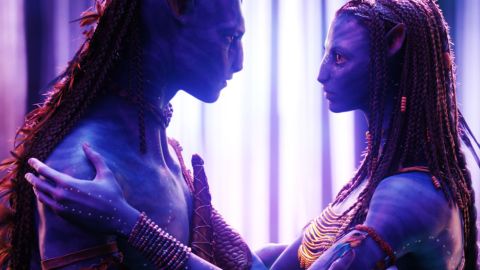Avatar: What’s Lost (And Found) In Translation

What’s the Big Idea?
Without realizing it, James Cameron has produced a parable about all forms of human communication, says David Bellos, a renowned translator and finalist for the 2012 National Book Critics Circle Award. “Our hero is one of us, transformed, and one of them.” Watch the video:
Avatar is set in the year 2154, when human beings have exhausted the Earth’s natural resources and corporations have expanded their mining projects into space. Pandora is the moon of a planet in the Alpha Centauri solar system, home to the Na’vi — and the only source of a valuable mineral called “unobtanium.” Our hero is Jake Sully (played by Sam Worthington), a former marine and paraplegic who is promised the restoration of his legs by the RDA Corporation if he will venture to Pandora and collect intelligence on the Na’vi.
To do so, he must use an avatar, a human-Na’vi hybrid, which will allow him to breathe the atmosphere of the planet, and also to blend in and communicate with the blue-skinned Na’vi. His mission is to exploit the trust of the people he meets, but over time, he begins instead to empathize with them, and ultimately finds himself taking their side over the humans’ in battle.
What’s the Significance?
What does this have to do with translation? Throughout the movie, it is unclear where Jake’s allegiances lie, emotionally or biologically. To what extent does having an avatar make him a N’avi? To what extent does falling in love with Neytiri (played by Zoe Saldana) and being accepted by the clan’s spiritual leader make him a part of the clan?
The question is: “Is our hero one of them or one of us?” says Bellos. Like Jake’s descent into Pandora, translation is liminal work. When a work is translated from one language to another, it undergoes a transformation. In the end, it’s unclear whether it is “what it was,” or something new. “Does it belong here or does it belong here?” For example, is an English translation of the Odyssey Greek literature, or is it part of the English canon? These questions are, of course, rhetorical — translation exposes the impossibility of clear-cut distinctions and categorizations.
And Avatar leaves them ambiguous. At the end, “that fundamental question about translation is answered just with an eye that opens. It’s left open-ended whether he is human or Pandoran or a mix of the two. Is sharing between the two possible?”
Bellos sees Avatar, and translation itself — moving between cultures — as a parable of the human condition.
“What I feel, you do not feel, and yet for us to have any kind of relationship, for society to exist, we have to assume that we share the same needs, the same desires, the same kinds of thinking, otherwise we wouldn’t be able to communicate. Translation makes manifest the human condition of being completely isolated and completely integrated at the same time.”
Editor’s Note: A previous version of this article used the word “allegience.” The correct spelling is “allegiance.” Thank you to reader Brad Morrison!





